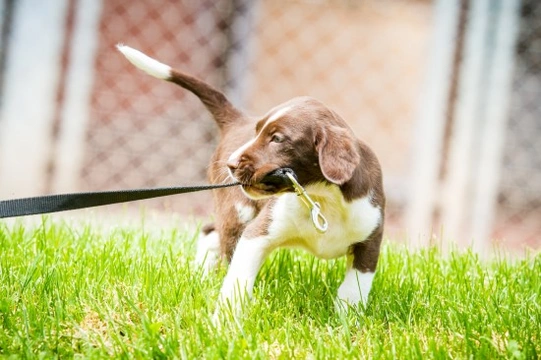
Training tips - Walking your puppy on the lead
Puppies are full of enthusiasm for life, and generally have a very sunny outlook on the world around them, and when they are young they are most receptive to training and picking up new skills. Training your puppy to walk on the lead is one of the most important aspects of your little dog’s training, and how you go about it and what your puppy learns from it will remain with your puppy throughout their whole life. However, it can prove challenging to know exactly how to go about lead training your puppy, and how to manage when your puppy doesn’t have a clue what is expected of them or views the lead as a toy! Read on for our top tips on walking your puppy on a lead.
Getting the right equipment
Before you begin, make sure you have all the tools for the job. You will need a comfortable and well-fitting collar for your pup, which your puppy should get used to wearing before you introduce the lead itself. You will also need a couple of leads, one flat lead of a suitable length for walking to heel, and a retractable lead too. You might also want to invest in a head collar to give you added control if your puppy is very strong or prone to lunging about, but do not begin your training with a choke collar, unless it becomes obvious that one is required after you have tried using a standard collar for some time.
How and when to begin
Your puppy should get used to wearing their collar as early as possible, certainly by around twelve weeks old. When you first introduce the lead, this should be done in the home or garden; do not expect to be able to walk your pup out in public from the get-go!
- Introduce your puppy to the lead for the first time when they are having their dinner; attach the lead to the collar and leave it hanging loose while they are eating. Remove the lead a little while after they have finished eating. Not only does this serve to introduce your dog to the lead when they have something else to occupy them, but it builds up a positive association in their mind with the lead equating something good, food in this case.
- After a couple of days, take a loose hold of the lead after your puppy has finished their meal, and follow your puppy around holding the lead, without attempting to use the lead to control or direct your pup. Gradually get your puppy used to the sensation of feeling that someone is on the end of their lead, and not to walk under your feet.
- Begin to train your dog to heel both on the lead and off the lead; walk slowly next to your dog holding a medium length lead, and use the “heel” command to show your puppy where to walk in relation to you. Be prepared to dish out plenty of treats over time, to demonstrate to your dog when they have got the hang of things.
- If your pup begins to pull the lead or tries to take off, turn around and walk in the other direction, keeping your dog on the outside of your turn so that he is gently pulled to follow you and has to speed up to keep up with you. Be prepared to go over this process several times, accompanying the “heel” command, and praising your pup when he gets things right.
- When your puppy can walk around with you in the home or garden safely and reliably, you are ready to take them out into the big wide world to continue their training.
Top tips on training your puppy to the lead
- Patience is key to any aspect of dog training; different dogs learn at different rates, so be prepared for training to take some time, and do not get annoyed or frustrated with your pup.
- Try to ensure that there is not a lot of outside stimulus going on around your puppy when you are trying to work with them; puppies are easily distracted, and will get excited if a lot is going on while they are learning!
- Don’t conduct your training sessions when your dog is excitable or brimming with excess energy; it can be helpful to tire them out a little first with play, then give them time to relax and calm down for a bit before commencing.
- Remember that highly intelligent dogs such as the Border Collie can prove more challenging to train than dogs that are not so bright, as they are more susceptible to inadvertently learning bad habits that you may not realise you are introducing. However, these dogs are very quick on the uptake and will generally pick up lead training fast!
- Nip problems such as pulling at the lead or lunging off in the bud right away, while your puppy is still small and young; allowing your puppy to get away with these things when they are little is a sure-fire way to end up with a large adult dog that pulls and is a challenge to walk.



